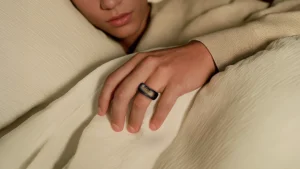
Feeling overwhelmed and unsure why? Discover how a tiny piece of tech can unlock profound insights into your mental well-being.
What You'll Learn:
- How smart rings go beyond fitness tracking to monitor mental health indicators.
- The science behind Heart Rate Variability (HRV) and its connection to stress.
- Practical benefits of using smart rings for stress management and sleep optimization in 2025.
- Key differences between smart rings and smartwatches for mental wellness.
- Factors to consider when choosing the right smart ring for your needs.
What Exactly is a Smart Ring for Mental Health?
Smart rings are evolving from niche gadgets to powerful wellness tools, offering a discreet yet comprehensive approach to understanding your body and mind.
Defining the Smart Ring: Beyond Basic Trackers
Unlike traditional fitness trackers that often focus solely on steps and calories, smart rings are designed for continuous, passive data collection. They integrate advanced sensors to monitor physiological signals that can indicate stress levels, sleep quality, and overall readiness. The goal is to provide users with actionable insights into their well-being without constant interaction. For a deeper dive into wearable technology trends, explore reports from Forrester Research.
The Core Promise: Discreet, 24/7 Wellness Monitoring
The primary appeal of a smart ring for mental health lies in its unobtrusive design. Worn on the finger, it's less conspicuous than a smartwatch and can be worn comfortably throughout the day and night. This allows for uninterrupted data capture, providing a more accurate and holistic picture of your physiological responses to daily life, stress, and rest.
How Smart Rings Differ from Smartwatches
While both devices track health metrics, their form factor and primary focus differ significantly. Smartwatches often prioritize notifications, app integration, and a wider range of features, which can be distracting for some. Smart rings, on the other hand, are built for minimalist monitoring, focusing on core physiological data like heart rate, temperature, and movement, making them ideal for users who want deep insights without constant digital interruption.
Decoding the Data: How Smart Rings Measure HRV and Stress
The magic behind smart rings' mental health capabilities lies in their ability to interpret complex physiological signals, most notably Heart Rate Variability (HRV).
Understanding Heart Rate Variability (HRV): Your Body's Stress Signal
Heart Rate Variability (HRV) refers to the variation in the time interval between consecutive heartbeats. It's not about your heart rate itself, but the subtle fluctuations within it. A higher HRV generally indicates a more adaptable and resilient nervous system, often associated with lower stress and better recovery. Conversely, a lower HRV can signal that your body is under stress, fatigued, or not adequately recovering. Understanding your HRV is a crucial step in managing your mental well-being. For more on the autonomic nervous system, a great resource is NIH's National Institute of Neurological Disorders and Stroke.
The Science: How Optical Sensors Capture HRV
Smart rings utilize photoplethysmography (PPG) sensors to measure HRV. These sensors emit light into your skin and detect the changes in light absorption as blood flows through your arteries. By analyzing these light patterns, the ring can accurately track your pulse and, more importantly, the tiny timing differences between each heartbeat. This data is then processed by sophisticated algorithms to calculate your HRV.
Key Metrics: Beyond Basic Heart Rate
While heart rate is a fundamental metric, smart rings offer more nuanced data for mental health insights:
- Heart Rate Variability (HRV): As discussed, this is a primary indicator of your body's stress response and recovery state.
- Resting Heart Rate (RHR): A consistently elevated RHR can be a sign of underlying stress or overexertion.
- Respiration Rate: Changes in breathing patterns can reflect emotional states and stress levels.
- Body Temperature: Fluctuations in skin temperature can correlate with stress and illness.
- Sleep Stages and Quality: Detailed sleep analysis is crucial for understanding mental recovery.
Unlocking Your Well-being: Benefits of Smart Rings for Mental Health in 2025
By providing continuous, data-driven insights, smart rings empower users to take a proactive approach to their mental health.
Proactive Stress Management and Burnout Prevention
In 2025, the emphasis is shifting from reactive treatment to proactive prevention. Smart rings can alert you to rising stress levels before they lead to burnout. By tracking HRV and other metrics, you can identify patterns associated with stressful events and implement coping strategies, such as mindfulness exercises or taking short breaks, to mitigate their impact.
Optimizing Sleep Quality for Better Mental Resilience
Sleep is foundational for mental health. Smart rings provide detailed breakdowns of your sleep cycles (light, deep, REM) and identify disruptions. Understanding your sleep patterns allows you to make informed adjustments to your bedtime routine, environment, and daily habits, ultimately leading to more restorative sleep and improved mood and cognitive function. For insights into sleep science, explore resources from CDC's Sleep and Sleep Disorders page.
Enhanced Recovery Insights: Balancing Activity and Rest
The concept of “readiness” is key. Smart rings help you understand how well your body is recovering from physical and mental exertion. This allows you to optimize your training and daily activities, ensuring you're pushing yourself effectively without overdoing it, which is crucial for preventing mental fatigue and promoting long-term well-being.
Gaining Actionable Insights for Daily Life
The true power of smart rings lies in translating raw data into understandable and actionable advice. Many companion apps offer personalized recommendations based on your metrics, suggesting when to push harder, when to rest, or when to focus on stress-reducing activities. This empowers you to make informed decisions that support your mental and physical health daily.
Smart Rings vs. Smartwatches: Which Wearable Fits Your 2025 Lifestyle?
Choosing the right wearable depends on your priorities and how you want to integrate technology into your life.
The Case for Discretion: Why Choose a Ring?
If your primary goal is discreet, continuous monitoring without the constant barrage of notifications, a smart ring is likely the better choice. Its minimalist design makes it suitable for all occasions and less intrusive for those who prefer to disconnect from digital distractions.
Battery Life and Charging Convenience
Smart rings often boast superior battery life compared to many smartwatches, sometimes lasting several days on a single charge. This means less frequent charging and more uninterrupted data collection, which is vital for tracking overnight sleep and continuous HRV.
Data Focus: Depth vs. Breadth of Features
Smart rings excel in depth of physiological data, particularly for metrics like HRV, sleep, and body temperature. Smartwatches offer a broader range of features, including GPS, mobile payments, and extensive app ecosystems.
Here's a quick comparison:
| Feature | Smart Ring | Smartwatch |
|---|---|---|
| Form Factor | Discreet, ring-shaped | Wrist-worn, larger display |
| Primary Focus | Core physiological health metrics, sleep, stress | Notifications, apps, fitness, communication |
| Data Depth | Deep insights into HRV, sleep, temperature | Broader health metrics, activity tracking |
| Discretion | High | Low to moderate |
| Battery Life | Often longer (3-7 days) | Varies greatly (1-2 days typical for feature-rich) |
| Notifications | Minimal to none | Frequent |
Choosing Your Smart Ring: Key Factors for 2025
With the growing market, selecting the right smart ring requires careful consideration of several factors.
Accuracy and Data Reliability: What to Look For
Accuracy is paramount for deriving meaningful insights. Look for rings that have undergone independent testing or have strong user reviews regarding data precision. Reputable brands often publish their research or testing methodologies. For an understanding of data accuracy standards in health tech, explore IEEE Standards Association.
Comfort and Fit: Essential for 24/7 Wear
Since you'll be wearing the ring constantly, comfort is non-negotiable. Ensure the ring is made from hypoallergenic materials and that you can find the right size for a snug but not tight fit. Many brands offer sizing kits to help you choose correctly.
App Experience and Data Accessibility
The companion app is your gateway to understanding your data. A user-friendly interface, clear visualizations, and personalized recommendations are crucial. Check reviews for app stability and how well it integrates with other health platforms you might use. If you're interested in how apps are built, resources like React.js documentation can offer insight.
Understanding Subscription Models and Costs
Some smart rings require a monthly or annual subscription to access all features and detailed data analysis. Factor this ongoing cost into your decision. While some offer basic tracking for free, advanced insights often come at a price.
FAQ (Frequently Asked Questions)
Q: Can a smart ring truly measure mental stress?
A: While a smart ring cannot diagnose mental health conditions, it can effectively measure physiological indicators of stress, such as Heart Rate Variability (HRV), resting heart rate, and sleep disturbances. By tracking these metrics, you can gain valuable insights into your body's stress response and make informed lifestyle adjustments.
Q: How often do I need to wear my smart ring for accurate data?
A: For the most comprehensive and accurate data, it's recommended to wear your smart ring 24/7, including while sleeping. This allows the device to capture continuous physiological signals that are essential for understanding your stress patterns, recovery, and sleep quality.
Q: Are smart rings reliable for tracking HRV?
A: Modern smart rings, especially those from reputable brands, use advanced optical sensors and algorithms that are generally considered reliable for tracking HRV. However, it's important to manage expectations; these are consumer-grade devices, not medical equipment. For medical diagnosis, always consult a healthcare professional. You can learn more about the science of heart rate monitoring on Coursera's health tech courses.
Q: What if I have sensitive skin? Can I still wear a smart ring?
A: Most smart rings are made from hypoallergenic materials like titanium or durable plastics. However, if you have particularly sensitive skin, it's advisable to check the specific materials used by the manufacturer and consider trying a ring for a short period initially to ensure no adverse reactions occur.
Conclusion
Smart rings are poised to revolutionize how we approach mental well-being in 2025, offering a discreet and powerful way to monitor stress through HRV and other key physiological metrics. By understanding your body's signals, you can proactively manage stress, optimize sleep, and enhance your overall resilience.
Ready to gain deeper insights into your mental health? Explore the latest smart ring options and start your journey to a more balanced life today!








